Parthenocissus quinquefolia
Parthenocissus quinquefolia, known as Virginia creeper, Victoria creeper, five-leaved ivy, or five-finger, is a species of flowering plant in the grape family, Vitaceae. It is native to eastern and central North America, from southeastern Canada and the eastern United States west to Manitoba and Utah, and south to eastern Mexico and Guatemala.
| Virginia creeper | |
|---|---|
| Scientific classification | |
| Kingdom: | Plantae |
| Clade: | Tracheophytes |
| Clade: | Angiosperms |
| Clade: | Eudicots |
| Clade: | Rosids |
| Order: | Vitales |
| Family: | Vitaceae |
| Genus: | Parthenocissus |
| Species: | P. quinquefolia |
| Binomial name | |
| Parthenocissus quinquefolia (L.) Planch. | |
| Synonyms | |
|
Ampelopsis hederacea Ehrh.[1] | |
Etymology
"Parthenocissus" is derived from Greek and means "virgin ivy" (hence the common name "Virginia creeper").[2] "Quinquefolia" means "five-leaved". "Quinque" – "five" and "folia" – "foliage", "leaves".[2]
Names
The name "Virginia creeper", referring to one of its native locations, is also used for the whole genus Parthenocissus, and for other species within the genus. The name Parthenocissus is from the Greek literally meaning "virgin ivy", and may derive from the common English name of this species.[3] It is not closely related to the true ivy, Hedera. The specific epithet quinquefolia means "five-leaved", referring to the leaflets on each compound (palmate) leaf.[4]
This plant is also known in North America as woodbine,[5] although woodbine can refer to other plant species.
Description
Parthenocissus quinquefolia is a prolific deciduous climber, reaching heights of 20–30 m (66–98 ft) in the wild. It climbs smooth surfaces using small forked tendrils tipped with small strongly adhesive pads 5 mm (0.20 in) in size.
Leaves
The leaves are palmately compound, composed of five leaflets (rarely three leaflets, particularly on younger vines, and sometimes seven) joined from a central point on the leafstalk, and range from 3 to 20 cm (1.2 to 7.9 in) (rarely to 30 cm [12 in]) across. The leaflets have a toothed margin. The species is often confused with P. vitacea or "False Virginia creeper", which has the same leaves, but does not have the adhesive pads at the end of its tendrils.
It is sometimes mistaken for Toxicodendron radicans (poison ivy), despite having five leaflets (poison ivy has three).[6] While the leaves of P. quinquefolia do not produce urushiol, the sap within the leaves and stem contains raphides (needle-shaped crystals of calcium oxalate) which can puncture the skin causing irritation and blisters in sensitive people.[7] .[8]
The leaves sometimes turn a decorative bright red in the fall.
Flowers and berries
The flowers are small and greenish, produced in inconspicuous clusters in late spring, and mature in late summer or early fall into small hard purplish-black berries 5 to 7 mm (0.20 to 0.28 in) diameter. These berries contain toxic amounts of oxalic acid and have been known to cause kidney damage and death to humans.[9][9][10][8] The berries are not toxic to birds and provide an important winter food source for many bird species.
Cultivation and uses
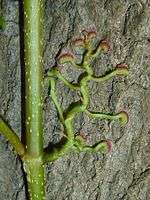
Parthenocissus quinquefolia is grown as an ornamental plant, because of its ability to rapidly cover walls and buildings, and its deep red to burgundy fall (autumn) foliage.[11]
It is frequently seen covering telephone poles or trees. It may kill other plants it covers by shading its support and thus limiting the supporting plants' ability to photosynthesize. With its aggressive growth, it can overburden slower-growing understory trees with its weight, damaging them. Its ability to propagate via its extensive root system makes it difficult to eradicate. This plant is listed on Schedule 9 of the UK Wildlife and Countryside Act 1981 as an invasive non-native species. While this does not prevent it from being sold in the UK, or from being grown in gardens, the Royal Horticultural Society (RHS) encourages those that do grow it to take great care with managing it and with disposing of unwanted material. The RHS also encourages gardeners to find alternative plants to grow to those listed on Schedule 9. For suggested alternative plants see the Plantlife/RHS guide: Gardening without harmful invasive plants
Parthenocissus quinquefolia can be used as a shading vine for buildings on masonry walls. Because the vine, like its relative P. tricuspidata (Boston ivy), adheres to the surface by disks rather than penetrating roots, it does not harm the masonry but will keep a building cooler by shading the wall surface during the summer. As with ivy, ripping the plant from the wall will leave the adhesive disks behind. If the plant clings to fragile surfaces it can first be killed by severing the vine from the root. The adhesive pads will then eventually deteriorate and release their grip. This plant should be trimmed regularly to keep it from growing into areas where it is not wanted. If allowed to penetrate into the wall of a frame house, it will grow upward within the wall until it finds a place to emerge.
The roots can penetrate a rock foundation and grow into the basement of an old house, extending long distances in search of moisture, and growing into floor cracks or drains.
See also
- Vine, general article on climbing plants
- Boston Ivy or Japanese creeper (P. tricuspidata, or Ampelopsis veitchii)
- False Virginia creeper (P. vitacea)
Gallery
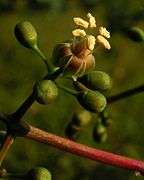 Flower
Flower Berries after the leaves have dropped in autumn
Berries after the leaves have dropped in autumn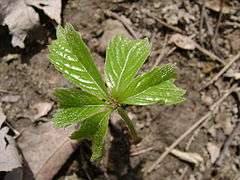 Emerging leaf in spring
Emerging leaf in spring- Thick vine
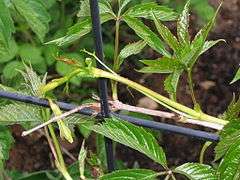 Tendrils beginning to twine around a metal trellis
Tendrils beginning to twine around a metal trellis- Fall color
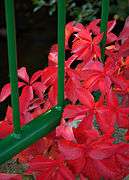 Fall color
Fall color
References
- "Virginia Creeper Ampelopsis hederacea Parthenocissus quinquefolia". Gardenvisit.com. Retrieved May 3, 2013.
- Gledhill, David (2008). "The Names of Plants". Cambridge University Press. ISBN 9780521866453 (hardback), ISBN 9780521685535 (paperback). pp 292, 324
- Coombes, Allen J. (2012). The A to Z of plant names. USA: Timber Press. pp. 312. ISBN 9781604691962.
- Harrison, Lorraine (2012). RHS Latin for gardeners. United Kingdom: Mitchell Beazley. p. 224. ISBN 9781845337315.
- Kenny, Hamill (1945). West Virginia Place Names: Their Origin and Meaning, Including the Nomenclature of the Streams and Mountains. Piedmont, WV: The Place Name Press. p. 690.
-

- "USDA NRCS Plant Guide - Virginia Creeper" (PDF). Retrieved 8 July 2014.
- USDA. "United States Department of Agriculture Plant Guide: Virginia Creeper" (PDF). Accessdata.fda.gov. Retrieved October 15, 2016.
- Earney, Delena Tull ; illustrations by Michael; Larke, Julia; Teague, Judy; Miller, Suzanne Rippe ; photographs by George Oxford (2013). Edible and useful plants of the Southwest : Texas, New Mexico, and Arizona : including recipes, teas and spices, natural dyes, medicinal uses, poisonous plants, fibers, basketry, and industrial uses (Revised ed.). pp. 184–185. ISBN 978-0292748279.
- "FDA Poisonous Plant Database". Accessdata.fda.gov. Retrieved October 15, 2016.
- "RHS Plant Selector - Parthenocissus quinquefolia". Retrieved 25 May 2013.
External links
| Wikimedia Commons has media related to Parthenocissus quinquefolia. |
| Wikisource has the text of the 1879 American Cyclopædia article Virginia Creeper. |
- USDA Forest Service fact sheet on Virginia Creeper (PDF)
- USDA Plant Guide (PDF)
- USDA Plant Factsheet (PDF)
- "Parthenocissus quinquefolia". Germplasm Resources Information Network (GRIN). Agricultural Research Service (ARS), United States Department of Agriculture (USDA).
- Parthenocissus quinquefolia images at bioimages.vanderbilt.edu
- http://plantstemcells.wikispaces.com/Virginia+Creeper+%E2%80%93+Ampelopsis+Weitchii
